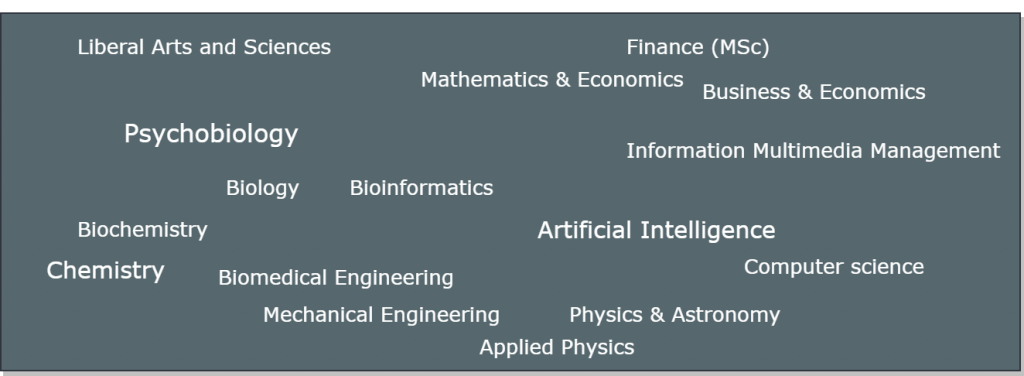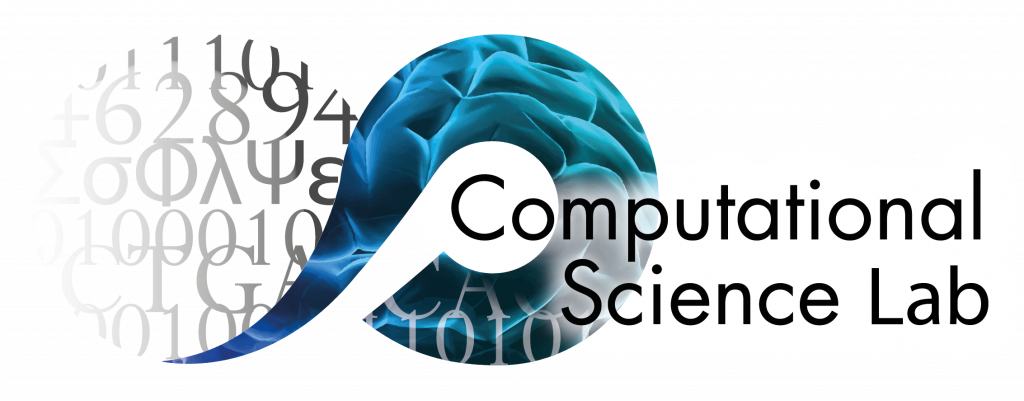Student survey
A questionnaire was spread among the students, to gather their opinions about the study program. Twenty-nine students responded, of whom one student started in 2015 and one in 2016, 14 respondents began in 2017, and 13 of the students began in 2018. All of the respondents were still studying in the year of 2018-2019. This section contains a summary of the survey results.
Student diversity
The Master of Computational Science puts great emphasis on interdisciplinary science and allows students from a wide array of backgrounds. Due to the wish to stay anonymous, not all students wished to state the title of their most recent degree. Those who did, collectively reported 16 different bachelor’s degrees and 1 master’s degree from vastly different fields. An overview is shown in the figure below.

Minor Computational Science
Aside from the master’s program, the Computational Science group also offers a minor. In fact, successfully completing the minor now provides guaranteed admission to the master’s program. More information about the Minor program can be found at https://minor.computationalscience.nl. Two of the students attended the Minor of Computational Science. Their reasons for applying included wanting to learn about programming, math, and complex systems. Both students were very positive about the course.
“The minor gave me the skills and confidence that I needed to start the master’s program.”
General opinion about the program
The majority of students based their decision to study computational science on the personalized study programs as well as the diversity in student’s backgrounds. The combination of science – in their respective fields – with math and programming appeals to the students. Some students also know alumni who recommended the program or were inspired during the masters’ event.
In general, students are satisfied with the program and the skills they have acquired. Most students think the program prepares them for the future and will provide excellent job opportunities.
The personal study programs were often one of the main reasons for choosing computational science and are therefore seen as fundamental. When asked about the diversity of courses, although the general opinion is positive, some students are disappointed. They had expected to be able to enroll in AI courses, but these are often full. Furthermore, students feel there’s a focus on computational finance and biology: in those areas, there’s a wide array of classes available. Students believe that fields like chemistry and physics are underrepresented and they would like more courses in, for example, astronomy, urban systems, and complexity science.
Students feel like members of the teaching staff are experts in their respective fields. The majority felt like the teaching staff was successful in passing on their knowledge.
Most students feel the courses are challenging. A few students, however, consider the classes too easy. The master program provides a group of core courses to equip all students with a basic level of knowledge. For some students, particularly those proficient in math, these courses lack a challenge. They feel that it might help to increase the weight of exams. Aside from the core courses, students get to choose their own path. This freedom to personalize their own study program is incredibly valuable to the students. A slight disadvantage is that the course difficulty can be unpredictable. Courses from different master’s programs often assume a basic level of knowledge the students do not yet possess. Students would like to have a clear overview of the skills required for the courses. That being said, these courses from other disciplines can be incredibly rewarding.
‘When you do something out of your field you sometimes need to do a lot of catching up, but you learn a lot and it can be super fun.’
Almost two-thirds of the students had a job at some point during their master’s, ranging from 2 to 20 hours a week. Some of the students lowered their course load when working for many hours. Others simply found it very easy to combine. Many of the students say that the course load and flexibility differ considerably between courses. Deadlines are sometimes set a bit late, which complicates things for working students.
Overall, students reported that their expectations were met. Some students had expected more theoretical knowledge was required, although several students appreciate the focus on implementation. As discussed previously, many students had counted on being able to choose AI courses and were disappointed these courses were not available to them. Aside from this, the students are pleased with the skills they acquired, and they enjoyed the master’s program.
“In general this is a great program that I recommend to all my friends!”
Specializations
The Master of Computational Science provides the opportunity to follow a specialization. Recommended course tracks are available in the fields of Computational Finance/Economics, Computational Biology, Computational Chemistry, Computational Biomedicine, and Computational Science. Furthermore, in consultation with the program director or thesis supervisor, tracks in Computational Earth Science or Scientific Computing/Numerical Math can be chosen. Although many students somewhat focus on one of these fields, only a few strictly follow a specialization track. Interestingly, although most of the students who officially pursue a specialization do this in their original domain, many students discover an interest in a different field during the degree.
International students
Eight international students replied to the survey, including one student who was born outside of the European Union. For the international students, the city itself and the study program presented important motivations to study in Amsterdam. The reputation of the Computational Science research group and the Dutch education system often played a role in the decision as well. One of the students mentions being inspired by an interview with Prof. Peter Sloot on the program homepage, where Prof. Sloot states that education should be multi-faceted.
“It is a very broad programme which you can essentially make your own which is fantastic and goes with what Peter Sloot mentioned in the interview on the CLS page. I chose Computer Science, AI, Data Science and even bioinformatics courses in addition to the Computational Science courses.”
| “It’s strange that people think you can understand big problems by looking at them from a monodisciplinary point of view. They require a multidisciplinary point of view. One of the most beautiful examples where all the sciences come together is climate change. It involves Physics, Chemistry, Biology, Economics and Sociology. However, we need a basic methodology to grasp complex processes. And that’s the aim of Computational Science: to see if we can describe these processes in such a way that we develop a predictive power.” – Prof. Peter Sloot in Q&A with Prof. Peter Sloot. |
Overall, students were satisfied with the support and information that was offered upon arrival in the Netherlands. However, there still is some room for improvement. One student suggests that course registration was difficult. Furthermore, the students felt they had not been sufficiently prepared for the difficulties in finding housing. Half of the students who responded are strongly dissatisfied with their housing situation. Multiple students point out that there have been periods during their master’s where they did not have a place to live. One of the students may not be able to start his second year due to a lack of residence.
The students are content with the quality of education and included by the other students.
“I learned a lot. Both my maths and my coding improved a lot and I learned a lot of new concepts.”
Joint degree
The Computational Science program is a joint degree between UvA and VU. Students are enrolled in both universities and have a broad collection of courses to choose from. But the joint degree does have its downsides. Administrative issues such as overlapping courses arise, although most students don’t see this as an issue. All except one of the students who filled in the survey identifies more with UvA than VU (the remaining student identifies equally with both). Students often feel better at home at Science Park and don’t know their way at the VU campus. This may be easily remedied by having an introduction day at VU aside from the UvA introduction.
Perhaps more alarming is that students perceive a quality difference between UvA and VU education. In fact, 86% of the students who replied to the questionnaire state that the teaching quality plays a significant role in whether they choose UvA or VU classes. Of those students, a quarter chooses to elaborate, all of whom report that UvA courses are more informative. For some students, location plays a role as well, but this effect is much smaller.
This being said, some students savor the joint degree. They like the broad array of courses, and they value the double logo on their diploma.
“Even if one selects courses only from UvA, a joint degree sounds more professional.”
When asked if the students would prefer a joint degree or a single degree, 12 students prefer a single degree, and 6 students prefer a joint degree. The other students have no preference in the matter.
